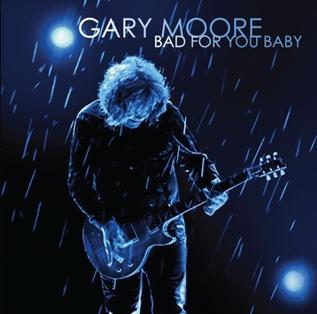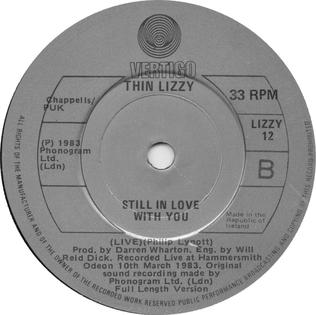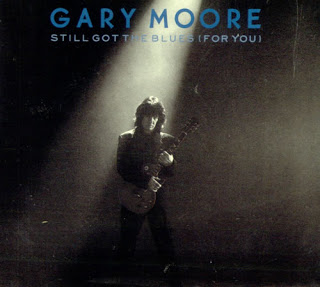Skid Row were an Irish blues rock band of the late 1960s and early 1970s, based in Dublin and fronted by bass guitarist Brendan "Brush" Shiels. It was the first band in which future Thin Lizzy members Phil Lynott and Gary Moore played professionally.

Thin Lizzy are an Irish hard rock band formed in Dublin in 1969. Their music reflects a wide range of influences, including blues, soul music, psychedelic rock and traditional Irish folk music, but is generally classified as hard rock or sometimes heavy metal.

Robert William Gary Moore was a Northern Irish musician. Over the course of his career he played in various groups and performed a range of music including blues, blues rock, hard rock, heavy metal, and jazz fusion.

Philip Parris Lynott was an Irish singer, bassist and songwriter. His most commercially successful group was Thin Lizzy, of which he was a founding member, the principal songwriter, lead vocalist and bassist. He was known for his distinctive pick-based style on the bass and for his imaginative lyrical contributions, including working class tales and numerous characters drawn from personal influences and Celtic culture.

William Scott Gorham is an American guitarist and songwriter who is one of the "twin lead guitarists" for the Irish rock band Thin Lizzy. Although not a founding member of Thin Lizzy, he served a continuous membership after passing an audition in 1974, joining the band at a time when the band's future was in doubt after the departures of original guitarist Eric Bell and his brief replacement Gary Moore. Gorham remained with Thin Lizzy until the band's breakup in 1983. He and guitarist Brian Robertson, both hired at the same time, marked the beginning of the band's most critically successful period, and together developed Thin Lizzy's twin lead guitar style while contributing dual backing vocals as well. Gorham is the band member with the longest membership after founders Brian Downey (drummer) and frontman and bass guitarist, Phil Lynott.

Vagabonds of the Western World is the third studio album by Irish hard rock band Thin Lizzy, released in 1973. It was the band's last album with original guitarist Eric Bell and the first to feature the artwork of Jim Fitzpatrick, whose work would appear on many subsequent albums by the band.

Black Rose: A Rock Legend is the ninth studio album by Irish rock band Thin Lizzy. Released in 1979, it has been described as one of the band's "greatest, most successful albums". It was the first time that blues rock guitarist Gary Moore remained in Thin Lizzy long enough to record an album—after previous brief stints in 1974 and 1977 with the band. The album peaked at No. 2 on the UK charts-- making it the band's highest-charting album in the UK. It was their fourth consecutive album to be certified Gold by the BPI.

Chinatown is the tenth studio album by Irish band Thin Lizzy, released in 1980. It introduced guitarist Snowy White who would also perform on the next album as well as tour with Thin Lizzy between 1980 and 1982; he replaced Gary Moore as permanent guitarist. White had previously worked with Cliff Richard, Peter Green and Pink Floyd. Chinatown also featured eighteen-year-old Darren Wharton on keyboards, and he joined Thin Lizzy as a permanent member later that year.

John James Sykes is an English guitarist, best known as a member of Whitesnake, Thin Lizzy and Tygers of Pan Tang. He has also fronted the hard rock group Blue Murder and released several solo albums.

Terence Charles "Snowy" White is an English guitarist, known for having played with Thin Lizzy and with Pink Floyd, and more recently, for Roger Waters' band. He is also known for his 1983 solo offering "Bird of Paradise", which became a UK Singles Chart Top 10 hit single.

Back on the Streets is the first album by Northern Irish guitarist Gary Moore, released in September 1978.

Still Got the Blues is the eighth solo studio album by Northern Irish guitarist Gary Moore, released in March 1990. It marked a substantial change in style for Moore, who had been predominantly known for rock and hard rock music with Skid Row, Thin Lizzy, G-Force, Greg Lake and during his own extensive solo career, as well as his jazz-fusion work with Colosseum II. As indicated by its title, Still Got the Blues saw him delve into an electric blues style.
Colosseum II was a British progressive jazz-rock band formed in 1975 by former Colosseum drummer and bandleader Jon Hiseman, which featured guitarist Gary Moore.

Whiskey In The Jar is a compilation album by Irish rock band Thin Lizzy, originally released in 1996, covering the early part of the band's career. There are various versions of this album, released by different record companies, with the same track listing but with different covers.

Grand Slam are an Irish rock band originally formed in 1984 by Phil Lynott, after the breakup of his earlier ensemble Thin Lizzy. Grand Slam was active for a year, and Lynott died in 1986, but the band was revived in 2016 by original member Mark Stanway.

Jan Russell Schelhaas is an English musician, mostly known as the keyboard player from the bands Caravan and Camel.

Bad for You Baby is the seventeenth and final solo album by Northern Irish blues guitarist and singer-songwriter Gary Moore.

"Still in Love with You" is a song originally recorded by Thin Lizzy. The studio version was first released on their 1974 album Nightlife, and went on to be a live favourite, showcasing the guitarists, including Brian Robertson, Scott Gorham, Gary Moore and John Sykes. Live versions were released on the albums Live and Dangerous, Life, BBC Radio One Live in Concert, The Peel Sessions and One Night Only.

This is the discography of the Northern Irish blues, heavy metal and hard rock guitarist and singer-songwriter Gary Moore.

"Still Got the Blues (For You)" is a song by Northern Irish guitarist Gary Moore. It was originally released as the title track of the album Still Got the Blues. The song was released as a single and reached number 31 on the UK Singles Chart in May 1990. It is the only single of Moore's solo career to chart on the US Billboard Hot 100, where it reached number 97 on 16 February 1991. Moore played his Les Paul Standard Guitar throughout the song. He also filmed a basic music video for the song.


















